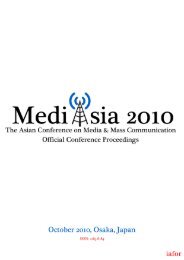t - Sabanci University Research Database
t - Sabanci University Research Database
t - Sabanci University Research Database
You also want an ePaper? Increase the reach of your titles
YUMPU automatically turns print PDFs into web optimized ePapers that Google loves.
the fact that the Merchant’s model doesn’t consider<br />
the effect of the strain, strain rate, and<br />
temperature on the material behavior. Also, the<br />
rake contact is simply represented by a sliding<br />
friction neglecting the effect of the plastic deformation<br />
on the rake face. The maximum difference<br />
between the proposed model predictions<br />
and the experimental results is around<br />
10% for both materials, whereas it is around<br />
20% for the Merchant’ model.<br />
shear angle - degrees<br />
(a)<br />
shear angle - degrees<br />
(b)<br />
38<br />
36<br />
34<br />
32<br />
30<br />
28<br />
26<br />
152m/min-exp 304m/min-exp<br />
24<br />
22<br />
152m/min-model<br />
152m/min-Merchant<br />
304m/min-model<br />
304m/min-Merchant<br />
0 0.05 0.1 0.15 0.2<br />
40<br />
35<br />
30<br />
25<br />
20<br />
feed rate - mm/rev<br />
150m/min-exp 300m/min-exp<br />
150m/min-model 300m/min-model<br />
150m/min-Merchant 300m/min-Merchant<br />
15<br />
0 0.05 0.1 0.15 0.2 0.25 0.3<br />
feed rate - mm/rev<br />
Figure 3: Comparison of shear angle predictions<br />
for (a) AISI 1050, and (b) AISI 4340 steels<br />
3.2 Cutting Force Predictions<br />
For a final verification, the cutting forces that<br />
are predicted by the proposed model are compared<br />
with the experimental results for various<br />
feed rates and cutting speeds. It should again<br />
be mentioned here that the apparent friction<br />
coefficients obtained from these tests are used<br />
in the force predictions. The results can be<br />
found in Figure 4 for the AISI 1050 steel and in<br />
Figure 5 for the AISI 4340 steel. As can be observed<br />
from the results, a strong agreement<br />
between the predictions and the experimental<br />
data is observed. The maximum and average<br />
discrepancies are 8% and 3%, respectively,<br />
which is mainly due to the inaccuracy in the<br />
material model. Although it is discussed in Section<br />
3.3, it should be mentioned here again that<br />
the parameters of the material model are calibrated<br />
by only the shear stress obtained from<br />
the tube cutting tests. The apparent friction coefficients<br />
obtained from the experiments are<br />
also used in the force prediction. These inputs<br />
enable the proposed model to predict even<br />
small changes in the forces with the cutting<br />
speed and feed rate.<br />
Feed Cutting Force - N<br />
(a)<br />
Tangential Cutting Force - N<br />
250<br />
200<br />
150<br />
100<br />
50<br />
0<br />
152m/min-exp<br />
302m/min-exp<br />
152m/min-model<br />
304m/min-model<br />
0.05 0.07 0.09 0.11 0.13 0.15<br />
700<br />
600<br />
500<br />
400<br />
300<br />
feed rate - mm/rev<br />
200<br />
152m/min-exp<br />
304m/min-exp<br />
100<br />
152m/min-model<br />
0<br />
304m/min-model<br />
0.05 0.07 0.09 0.11 0.13 0.15<br />
(b)<br />
feed rate - mm/rev<br />
Figure 4: The (a) feed cutting force, and (b)<br />
tangential cutting force comparisons for the<br />
AISI 1050 steel.<br />
3.3 Discussion on the constitutive model<br />
As mentioned in Section 2.2 the only inputs required<br />
by the model are the material parameters<br />
and the friction coefficient. An approach to<br />
obtain the friction coefficient is proposed and<br />
verified by the experiments in aforementioned<br />
analysis. However, the selection of Johnson<br />
Cook parameters is another important issue in<br />
the analysis. A common method to obtain the<br />
material parameters is the Split-Hopkinson<br />
Pressure Bar (SHPB) test. However, the strain<br />
rates in metal cutting may reach the order of<br />
105 s -1 , whereas they are usually restricted to<br />
104 s -1 in SHPB tests [41], which may be an<br />
error source. In this section, the selection procedure<br />
and effects of the Johnson Cook parameters<br />
on the cutting forces for AISI 4340<br />
steel will be given. The same strategy for the<br />
AISI 1050 steel is followed. Three different parameter<br />
sets found in the literature [42-44] for<br />
AISI 4340 steel are listed in Table 2.<br />
Set A(MPa) B(MPa) n m ν<br />
2 792 510 0.26 0.014 1<br />
3 950 725 0.375 0.015 0.625<br />
4 910 586 0.26 0.014 1.03<br />
Table 2: The JC parameters for 4340 steel obtained<br />
from three different studies [42-44].









